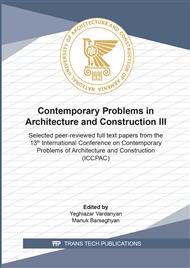[1]
S.A. Kurkin, The strength of welded thin-walled vessels operating under pressure, Mashinostroenie, Moscow, (1986).
Google Scholar
[2]
B.V. Zverkov, D.L. Kostovetsky, Sh.N. Katz, et al., Calculation and construction of pipelines: Tutorial-handbook, Mashinostroenie, Leningrad, (1979).
Google Scholar
[3]
V.I. Trufyakov, Fatigue of welded joints, Naukova dumka, Kiev, (1973).
Google Scholar
[4]
Information on https://www.belzona.com/ru/index.aspx.
Google Scholar
[5]
A.F. Dashchenko, V.S. Kravchuk, V.D. Iorgachev, Bearing capacity of hardened machine parts, Astroprint, Odessa, (2004).
Google Scholar
[6]
O.I. Steklov, Resistance of materials and structures to stress corrosion, Mashinostroenie, Moscow, (1990).
Google Scholar
[7]
N.V. Oleynik, A.V. Volchev, S.V. Bershak, et al., Calculation of machine parts for corrosion fatigue, Technika, Kiev, (1990).
Google Scholar
[8]
I.A. Birger, B.F. Shor, G.B. Iosilevich, Calculation of the strength of machine parts: Handbook, Mashinostroenie, Moscow, (1989).
Google Scholar
[9]
M. G. Stakyan, A. A. Kazaryan, Yu. A. Kazaryan, Research of loading modes of the gas transport system, Scientific Papers of NUACA. 2(64) (2016) 120-125.
Google Scholar
[10]
V.P. Kogaev, Calculations for strength at stresses, variables in time, Mashinostroenie, Moscow, (2003).
Google Scholar
[11]
Building Codes 25. C04-82. Calculations and strength tests. Methods for calculating the fatigue resistance characteristics, Izd-vo standartov, Moscow,(1983).
Google Scholar
[12]
V.P. Kogaev, N.A. Makhutov, A.P. Gusenkov, Calculations of machine parts and structures for strength and durability: Reference book, Mashinostroenie, Moscow, (1985).
Google Scholar
[13]
V.N. Orlov, Innovative technologies for ensuring the reliability of working elements and equipment, MGUPb, Moscow, (2013).
Google Scholar
[14]
A.T. Skoybeda, A.V. Kuzmin, N. N. Makeychik, Details of machines and the basics of design, Higher School, Minsk, (2006).
Google Scholar
[15]
P.F. Dunaev, O.P. Lelikov, Design of assemblies and machine parts, Academy, Moscow, (2008).
Google Scholar
[16]
G.S. Chibukhchyan, M.G. Stakyan O.S. Chibukhchyan, Improving the Carrying Capacity of Structural Elements of Vehicles by the Corrosive Strength Criterion, Journal of Machinery Manufacture and Reliability, 48(6) (2019) 551-556.
DOI: 10.3103/s1052618819060037
Google Scholar
[17]
N. Pirumyan, M.Stakyan, Bearing capacity of elements of a gas transportation system, E3S Web of Conference, 97 (2019) 04027 1-9.
DOI: 10.1051/e3sconf/20199704027
Google Scholar
[18]
I.V. Kudryavtsev, N.E. Naumchenov, Fatigue of welded structures, Mashinostroenie, Moscow, (1976).
Google Scholar
[19]
M.N. Stepnov, A.V. Shavrin, Statistical methods of processing the results of mechanical tests: Reference book, Mashinostroenie, Moscow, (2005).
Google Scholar
[20]
N. Pirumyan, M. Stakyan, G.Galstyan, Mathematical modeling of the test process of construction materials, Key Engineering Materials. 828 (2019) 115–120.
DOI: 10.4028/www.scientific.net/kem.828.115
Google Scholar
[21]
N. Pirumyan, M. Stakyan, G. Galstyan, Software processing of the test results of building materials, Key Engineering Materials. 828 (2019) 121-128.
DOI: 10.4028/www.scientific.net/kem.828.121
Google Scholar
[22]
N. Pirumyan, M. Stakyan, The strengthening technologies' application in building steel structural elements, IOP Conf. Ser.: Mater. Sci. Eng. 913, 022036 (2020) 1-6.
DOI: 10.1088/1757-899x/913/2/022036
Google Scholar
[23]
N. Pirumyan, M. Stakyan, Measures to increase the building steel structures' bearing capacity, IOP Conf. Ser.: Mater. Sci. Eng. 913(2), 022006 (2020) 1-6.
DOI: 10.1088/1757-899x/913/2/022006
Google Scholar
[24]
N. Pirumyan, M. Stakyan, Asessment of corrosion fatigue strength of gas-transport system constructions under atmospheric forcing, IOP Conf. Ser.: Mater. Sci. Eng. 698(2), 022077 (2019) 1-6.
DOI: 10.1088/1757-899x/698/2/022077
Google Scholar
[25]
N. Pirumyan, M. Stakyan, The building structures' bearing capacity assessment with the nomogram 7method, IOP Conf. Ser.: Mater. Sci. Eng. 913, 022035 (2020) 1-7.
DOI: 10.1088/1757-899x/913/2/022035
Google Scholar


